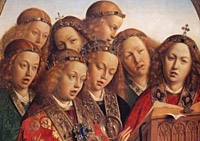period: Renaissance
 "Renaissance" is, of course, the French word for "re-birth", and refers most literally to the renewed interest among artists and thinkers of the 15th and 16th centuries in the philosophy and culture of Ancient Greece and Rome. More broadly it has come to signify the "re-birth" of human creativity during this period, an unprecedented flowering of arts, letters, and science, a golden era of discovery, and the veritable birth of the modern era - the age of Leonardo, Michelangelo, Erasmus, Copernicus, and Columbus. Though perhaps less well-known today, the music of the Renaissance is likewise worthy of this same high esteem, as the greatest composers of the age achieved an artistic success equal to that of their more famous contemporaries in the visual and literary arts.
"Renaissance" is, of course, the French word for "re-birth", and refers most literally to the renewed interest among artists and thinkers of the 15th and 16th centuries in the philosophy and culture of Ancient Greece and Rome. More broadly it has come to signify the "re-birth" of human creativity during this period, an unprecedented flowering of arts, letters, and science, a golden era of discovery, and the veritable birth of the modern era - the age of Leonardo, Michelangelo, Erasmus, Copernicus, and Columbus. Though perhaps less well-known today, the music of the Renaissance is likewise worthy of this same high esteem, as the greatest composers of the age achieved an artistic success equal to that of their more famous contemporaries in the visual and literary arts.
Early signs of a Renaissance musical aesthetic appeared in the works of English composers of the early 15th century, such as John Dunstaple and Lionel Power, where a new emphasis on simplicity and pleasing consonance (3rds, 6ths) contrasted with the more mannered and austere style of the Late Middle Ages. Within a short time, composers on the Continent, especially France, took heed of the new style and expanded it to even greater expressive heights, most especially Guillaume Dufay and Gilles Binchois in the 1430s-50s. In the succeeding two generations, a series of top-rank composers emerged, mostly from the region known as Flanders (Northern France, Southern Belgium): first that of Johannes Ockeghem and Antoine Busnois in the 1470s and 80s, and then that of Josquin des Prés in the "golden era" between 1490-1520 - which likewise included such giants as Heinrich Isaac, Loyset Compère, Jacob Obrecht, among others. Indeed, Josquin must be considered among the greatest composers of any age for his unrivaled mix of stunning technique and intense expression; in so doing, Josquin and his contemporaries fulfilled the promise of the new philosophy of Humanism, though always in consort with the era's deep religious conviction. The dominant genres of this Early- to High-Renaissance period - all vocal - included the religious Mass cycle and the motet, as well as the secular or "courtly love" chanson. From the 1530s, however, a new, more literary secular vocal genre took hold of composers and audiences alike, the madrigal - whose popularity was aided by the fledgling music printing industry. Outstanding madrigal composers included Jacob Arcadelt and Cypriano de Rore in its early phase and Orlando de Lassus and Adrian Willaert in its so-called "classical era". This is to not to suggest that religious genres held a diminished role in the Late Renaissance, as the top composers - Lassus, Giovanni Pierlugi da Palestrina, Tomás Luis de Victoria, and William Byrd - all wrote substantial amounts of sacred vocal music. As the 16th century wore on, composers of both sacred and secular music increasingly strove for a commensurate musical rendering of the extreme, even mannered, emotional content of the texts - and thus laid the groundwork for the next era, the Baroque.

Nolan Gasser, PhD
Artistic Director
















